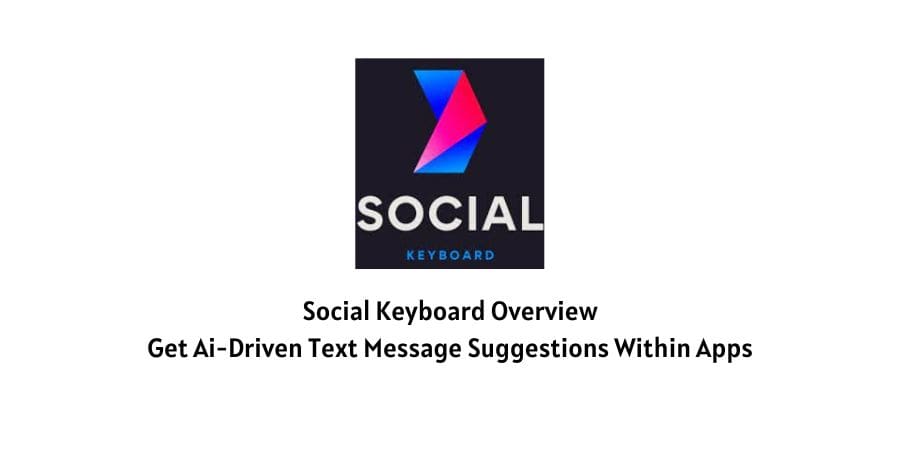
Social Keyboard is an application that adds a system keyboard to your device to provide AI-driven messaging suggestions within apps — powered by a large language model.
As generations continue to rely on text-based messaging more and more, we figured there surely would be opportunities to improve this process.
Also, it seems that some people are not the best at text messaging which could have consequences on every part of your life: professional (Slack, etc.), personal (Tinder, etc.), and friendships (SMS messaging, etc.).
Also, as more devices continue to be invented (AR/VR, gaming consoles, Smart TVs), we believe that the need for new ways to message will grow.
So, we created Social Keyboard to help users like ourselves that want assistance in the inevitable battle of crafting messages all day (and sometimes night).
Key features of social keyboard
One of the main features of Social Keyboard is the ability to generate natural, complete, and editable messages in response to messages that you have received from others. As you try out the application, you should test its limits with text that is error-ridden, loaded with slang, or even messages you don’t understand. This feature’s capability has impressed users the most and is continuing to improve.
Social Keyboard also generates rewording suggestions. So, after you have written a response to a message, you can open the keyboard and take a peek at some different ways you could reword your text. Rewording is helpful in situations where you know what you want to say but are unsure of the best way to say it. Unfortunately, we feel the rewording feature seems to be one of the most underutilized features.
The final two (and necessary) features of Social Keyboard are tone selection and conversation initiation. Tone selection is essential because we recognize that different users have different texting styles and may even vary them across different contexts (working or personal). Conversation initiation can be great when you want to use an intro that you may or may not use often.
Pros and cons of social keyboard
Pros
One of the benefits of Social Keyboard is that it can truly save people time. There are tons of metrics around how much time people waste texting on their phone that don’t account for professional messaging (like Slack or Customer Service) or other messaging (like Tinder or Instagram). So reading and crafting responses to longer messages is where Social Keyboard shines.
Social Keyboard can help users who are not particularly fond of messaging, are not native to that particular language, or are not the best at it. For example, the application can provide message responses or rewrite suggestions to messages with acronyms, slang-ridden, or grammatically incorrect text.
The key to Social Keyboard is that it doesn’t automatically just generate a response; it gives you suggestions to choose from (typically 5). Then, you can select and edit the text from those suggestions before sending it off.
Cons
One of the application’s drawbacks is that it can be slow at generating suggestions as it can take slightly more time than competitors.
The Large Language Model takes time to compute the absolute best responses, and we have a host of improvements that we are working on to decrease response time.
How to use Social keyboard?
Unfortunately, you must take a few steps to enable the custom keyboard:
- Download, open, and subscribe to the application via Google Play. *This step is essential.
- Select a tone you’d like to use in your messaging
- In whichever messaging app you’d like to use the keyboard, select it from the keyboard list.
- Granted, you have done the previous steps correctly; you should see the UI for Social Keyboard in the keyboard list menu.
- Either click “initiate new conversation,” paste the message to respond to, or have it rewrite the text you have already written in the target text field.
social keyboard FAQS
You must subscribe to the Google Play Subscription within the Social Keyboard app before enabling it in your Android settings. Once you subscribe to the app, it will provide instructions on how to enable the keyboard.
Tools like Google Smart Reply seem to have more straightforward suggestions to much simpler input. Social Keyboard uses one of the human-like language models to generate messages to the most complex and slang-filled input text.
No. Not selling your data is one of the main reasons for the monthly fee, so we never have to sell your data.
The Apple iOS application will be released very shortly. We are doing our best to ensure that every native application we release uses that environment’s best features. There are also more platforms we are planning to support in the future so stay tuned.
We do not believe our product will harm society, but we can’t speak to all products in the industry. We believe that many of the concerns around the safety of AI are valid, but in building Social Keyboard, we did our best to mitigate these concerns in our software. We believe that Social Keyboard reflects the best of the current state of AI (and technology in general), which is creating tools to assist humans.
There are two general flavors of language models: small language models and large language models. Small language models are typically limited to a few predefined responses, while large language models can understand and respond to a much more comprehensive range of messages. Large language models, on the other hand, are designed to handle a much more comprehensive range of conversations. However, they are not without their problems, as they have seen so much data that they are generally considered less “Safe” with known issues of “Bias.” We have done our best to mitigate safety risks in our product, but hopefully, the more consumers we can get the product into their hands, the better we can make it. You can read more from our Medium article.
Like This Post? Checkout More
